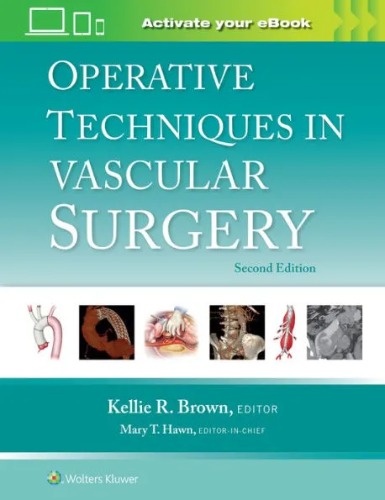이 책의 특징
With an emphasis on the “hows and whys” of contemporary surgery,Operative Techniques in Vascular Surgery, Second
Edition, features concise, bulleted text, full-color illustrations, and intraoperative photographs to clarify exactly
what to look for and how to proceed. Drawn from the larger Operative Techniques in Surgery, Second Edition, this
concise, stand-alone surgical atlas, overseen by editor-in-chief Mary T. Hawn and meticulously edited by Dr. Kellie R.
Brown, focuses on the steps of each technique, rapidly directing you to the information you need to choose the right
approach for each patient, perform it successfully, and achieve the best possible results.
the thoracic outlet; thoracic and suprarenal aortic exposure and treatment; visceral and renal artery disease
management; infrainguinal arterial disease management; surgical management of venous disease; and vascular injury
trauma
for General Surgery as well as dialysis access and amputation techniques
and other diagnostic studies, surgical management, techniques, pearls and pitfalls, postoperative care, outcomes, and
complications
Enrich Your eBook Reading Experience
Video Contents List
Section I: Cerebrovascular Arterial Surgery/ Intervention
Chapter 01: Arch and Great Vessel Revascularization and Reconstruction
Chapter 02: Extrathoracic Revascularization (Carotid–Carotid, Carotid–Subclavian Bypass and Transposition)
Chapter 03: Carotid Surgery: Interposition/Endarterectomy (Including Eversion)/Ligation
Chapter 04: Transcarotid Artery Revascularization (TCAR)
Chapter 05: Carotid Surgery: Distal Exposure and Control Techniques and Complication Management
Chapter 06: Repair of Internal and External Carotid Injury
Section II: Management of the Thoracic Outlet
Chapter 07: Vertebral Transposition Techniques and Stenting
Chapter 08: Neurogenic Thoracic Outlet Syndrome Exposure and Decompression: Supraclavicular
Chapter 09: Neurogenic Thoracic Outlet Syndrome Exposure and Decompression: Transaxillary
Chapter 10: Venous and Arterial Thoracic Outlet Syndrome
Section III: Thoracic and Suprarenal Aortic Exposure and Treatment
Chapter 11: Exposure and Open Surgical Reconstruction in the Chest: The Thoracoabdominal Aorta
Chapter 12: Thoracic Aortic Stent Graft Repair for Aneurysm, Dissection, and Traumatic Transection
Chapter 13: Arterial Injury
Chapter 14: Retroperitoneal Abdominal Aortic Exposure for Visceral Aortic Endarterectomy
Chapter 15: Hybrid Revascularization Strategies for Visceral/Renal Arteries
Chapter 16: Parallel Stenting for Visceral and Renal Protection During Complex Endovascular Aneurysm Repair
Chapter 17: Branched and Fenestrated Endovascular Stent Graft Techniques
Section IV: Visceral and Renal Artery Disease Management
Chapter 18: Stenting, Endografting, and Embolization Techniques: Celiac, Mesenteric, Splenic, Hepatic, and Renal Artery
Chapter 19: Visceral Reconstruction to Facilitate Cancer Management: Celiac, Mesenteric, Splenic, Hepatic, and Renal
Chapter 20: Open Renal Revascularization: Hepatorenal, Splenorenal, and Aortorenal Bypass
Chapter 21: Open Visceral Revascularizations for Ischemia: Superior Mesenteric Artery Embolectomy, SMA/Celiac
Chapter 22: Advanced Aneurysm Management Techniques: Open Surgical Anatomy and Repair
Chapter 23: Advanced Aortic Aneurysm Management: Endovascular Aneurysm Repair—Standard and Emergency Management
Chapter 24: Advanced Aneurysm Management Techniques: Management of Internal Iliac Artery Aneurysm Disease
Chapter 25: Aortoiliac Occlusive Disease: Open Surgical Management
Chapter 26: Aortoiliac Occlusive Disease: Endovascular and Hybrid Management
Section V: Infrainguinal Arterial Disease Management
Chapter 27: Surgical Exposure of the Lower Extremity Arteries
Chapter 28: Management of the Infected Femoral Graft
Chapter 29: Femoral Pseudoaneurysm Management: Open and Endovascular
Chapter 30: Infrainguinal Embolectomy Techniques
Chapter 31: Percutaneous Femoral-Popliteal Reconstruction Techniques: Antegrade Approaches
Chapter 32: Tibial Interventions: Tibial-Specific Angioplasty Considerations and Retrograde Approaches
Chapter 33: Open Infrainguinal Reconstruction Techniques
Chapter 34: Perimalleolar Bypass and Hybrid Techniques
Chapter 35: Popliteal Aneurysm Management: Open and Endovascular Repair
Section VI: Surgical Management of Venous Disease
Chapter 36: Acute Iliofemoral Deep Vein Thrombosis and May-Thurner Syndrome: Surgical and Interventional Management
Chapter 37: Vena Cava Filter Placement and Removal
Chapter 38: Superficial Venous Disease Management: Ablation, Phlebectomy, and Sclerotherapy
Chapter 39: Thoracic Vascular Injury—Venous: Brachiocephalic Vein, Subclavian Vein
Chapter 40: Vascular Injury—Neck: Internal Jugular Vein
Section VII: Dialysis Access
Chapter 41: Hemodialysis: Open Access Construction
Chapter 42: Hemodialysis Catheter Placement and Maintenance
Chapter 43: Insertion of a Peritoneal Dialysis Catheter: An Alternative to Creating Vascular Access in the Treatment
of Renal Failure
Section VIII: Amputation
Chapter 44: Toe and Foot Amputations: Ray/Transmetatarsal/Symes
Chapter 45: Lower Extremity Amputation: BKA/AKA/Hip Disarticulation
Section IX: Vascular Injury—Abdominal
Chapter 46: Zone I Injuries
Chapter 47: Abdominal Vascular Injury Zone II
Chapter 48: Abdominal Vascular Injury Zone III
Section X: Vascular Injury: Extremities
Chapter 49: Lower Extremity Vascular Trauma—Femoral and Popliteal With Infrapopliteal Fasciotomy
Chapter 50: Upper Extremity: Axillary, Brachial, Radial/Ulnar Fasciotomy
Index


